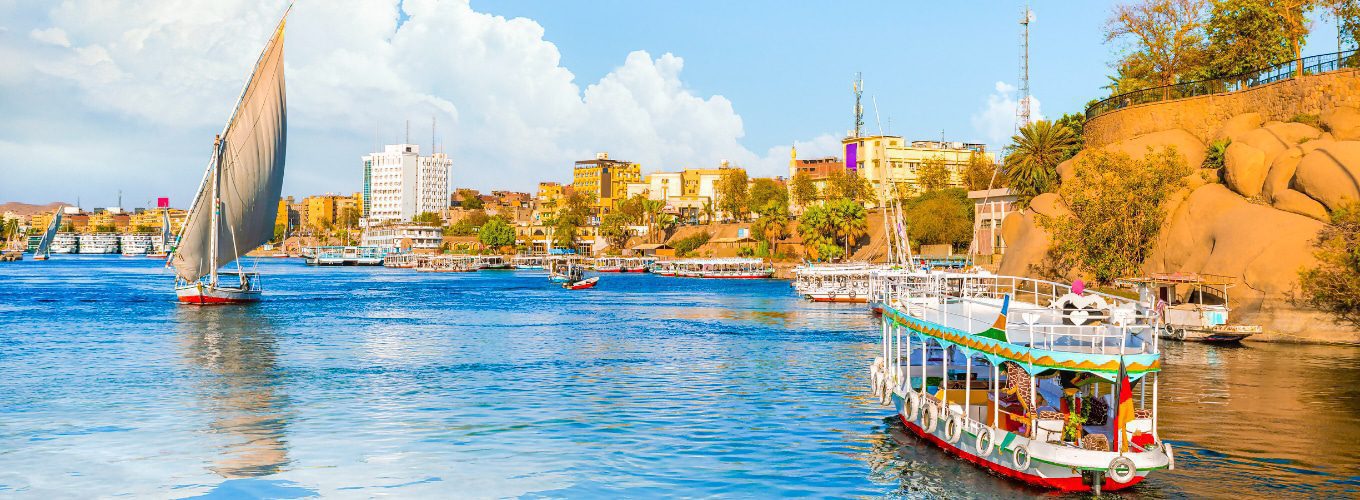Looking for a destination that will ignite your sense of wonder and leave you with lifelong memories? Aswan, nestled along the mesmerizing Nile River in Egypt, is the perfect answer. With many Things to do in Aswan and a rich tapestry of experiences, this vibrant city offers great things to do in Aswan that will captivate adventurers, culture enthusiasts, and nature lovers alike.
Step back in time and immerse yourself in the mysteries of ancient Egypt. Aswan is home to some of the most remarkable historical landmarks in the world. Start your journey at the iconic Philae Temple, an architectural marvel adorned with intricate carvings and surrounded by the Nile’s serene waters. The stories of pharaohs and mythological gods come to life as you wander through its awe-inspiring halls.
Whether you’re drawn to ancient history, thrilling adventures, or serene landscapes, Aswan is the ultimate destination. So pack your sense of adventure and curiosity, and let Aswan unlock the wonders of Egypt before your eyes. Prepare for an unforgettable journey that will stay with you long after leaving this vibrant gem along the Nile. The treasures of Aswan await your discovery!

Aswan City History
Aswan was known as “Sono” in ancient Egyptian, meaning the market. It was a trading center for caravans coming to and from Nubia, and the pharaohs shipped pink and black granite and limestone stones from Aswan to build their pyramids as queen.
Hatshepsut built her temple and obelisks.
The importance of this city began to appear in the Old Kingdom when the pharaohs wanted to ensure the safety of the kingdom’s southern borders.
It was also a center for the military army and played a remarkable base during the war against the Hyksos. During the Roman era, temples of ancient Egyptian design were constructed.
While the Romans were very impressed with Egyptian myths and gods, Emperor Trajan built a small temple to get closer to the Egyptian people on the island of Philae, where the Temple of Isis is the main temple in the group of Philae temples in Aswan.
The name Philae is derived from the Greek word Philo, which means affection or love, referring to the temple commemorating the wife’s sincere love for her husband, whom his brother betrayed—evil God Group.
Then, in the early Christian era, Christianity spread throughout the country. In the fifth century A.D., temples were transformed into churches, after which Islamic innovation came; Aswan became a vital educational center, and three schools were established in the sixth and seventh Centuries.
Things to see in Aswan
Aswan was the southernmost fortified city of the ancient Egyptian kingdoms, and Aswan was important to the pharaohs in ancient times.
There were many quarries from which building materials for temples and palaces were extracted, and then they were transported across the Nile to Thebes using felucca.
The giant obelisks adorn Luxor Temple’s entrance (and the Place de la Concorde in Paris) also come from Aswan. You will find everything you need to know about Aswan in this article.
1- Abu Simbel

Abu Simbel Temple is one of the most beautiful ones. It is a group of two temples near the southern border of Egypt in Aswan. It was built for King Ramses II,d it, and is 320 km from this temple to Aswan.
Abu Simbel Temple is the essential building site in southwest Aswan, and it is made up of two temples that have been dug up. Both the Temple of Ramses and the Temple of Queen Nefertari were built during the time of King Ramses II (1290–1223 BC) and showed how great and glorious the ancient Egyptian kingdom was.
The Abu Simbel temple honors the old Egyptian gods Amun-Ra, Harmakis, and Ptah. Four statues of the pharaoh tell the story of the temple.
The different styles of these temples showed how far the modern kingdom had come and how well it had done. Still, the Nile flood was terrible for these private temples, so the Egyptian government and UNESCO worked together to keep these temples from sinking.
Discover the majesty of Abu Simbel with these essential tips for a memorable visit:
- Go early to beat the heat and the crowds.
- Book your transportation and guide in advance, especially if you’re traveling during peak season.
- Bring plenty of water and sunscreen, and wear comfortable shoes and clothing.
- Don’t forget to bring your camera to capture the stunning scenery.
- Be respectful of the temples and their significance to Egyptian culture.
Additional info.
Opening Times: Daily, 5:00 AM – 6:00 PM.
How to Get There: Best accessed via a short flight from Aswan; tours are also available.
Travel Tips: Witness the iconic sound and light show in the evening for a unique experience.
Fun Facts: The Abu Simbel Temples were relocated in the 1960s to save them from Lake Nasser submerging them.
2- Philae Temple
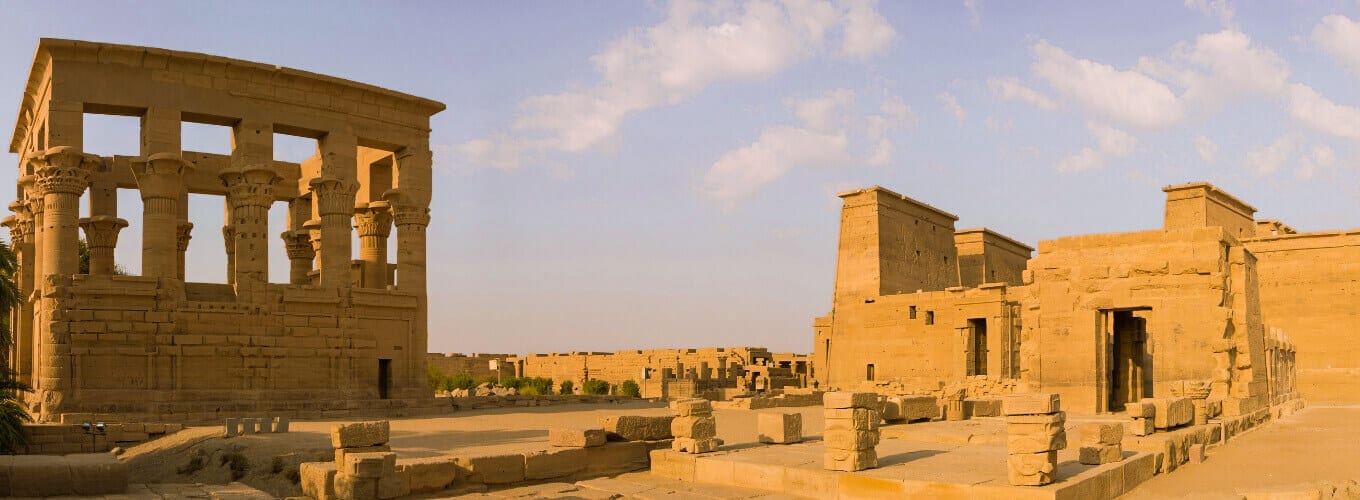
Philae Temple is one of the essential attractions in Aswan. The temple complex was moved to Agilkia Island in the 1970s after its original site, Philae Island, flooded. The 25th Dynasty is when the oldest building at Philae was built. It was later turned into a temple of Isis, which still takes up a large part of the island.
The temple also has a “mamisi,” which means “birth house,” and a small chapel for the goddess Osiris’s husband. Nectanebo II made the first building. The Hall of Ten Columns, which Ptolemy IX Evargate II built, is up a flight of stairs from the door of the second tower. After going through other rooms, you reach the sanctuary, an integral part of the temple.
The cult of the goddess Isis used to be based at the Philae Temple. From the time of the Pharaohs until the time of the Greeks, Romans, and Byzantines, the temples of Philae were very important. Each ruler was added to the stones here.
Make the most of your trip to the Philae Temple with these expert recommendations:
- Take a boat trip to the island.
- Buy your ticket online in advance.
- Arrive early to beat the crowds.
- Wear comfortable shoes and sun protection.
- Bring water and snacks.
- Take your time to explore the temple.
- See the light and sound show at night.
- Take a felucca ride on the Nile River.
Additional info.
Opening Times: Daily, 8:00 AM – 5:00 PM.
How to Get There: Reachable by boat from Aswan; guided tours are common.
Travel Tips: Explore the temple dedicated to the goddess Isis and the magnificent surroundings.
Fun Facts: Philae Temple was relocated stone by stone to its current location on Agilkia Island.
3- Unfinished Obelisk

The Unfinished Obelisk in Aswan, Egypt, resembles a giant sleeping on a granite bed. It is a fantastic look at how these massive, one-piece monuments were built. The unfinished obelisk is an attraction in the quarries near Aswan. At 42 meters, it would have been the largest giant obelisk ever erected had it been completed. Its construction is believed to have been commissioned by Queen Hatshepsut and was intended for the Karnak Temple.
Even after thousands of years, the Egyptian civilization, culture, way of life, and impressive buildings are still a mystery. Historians and archaeologists have come up with hundreds of theories about it. Theories based on humans and gods try to explain how such an old civilization could have had the skills and knowledge to build such complex and elaborate buildings. They might have talked to intelligent beings from other planets.
Uncover the ancient secrets of the Unfinished Obelisk with our helpful suggestions:
- Take a taxi or tuk-tuk to the Unfinished Obelisk.
- Wear comfortable shoes and clothing, as the ground can be uneven.
- Bring water and a hat, as there is little shade.
- Be careful when climbing on or around the obelisk, as it is unstable.
- Take your time to explore the site and learn about its history.
- Combine visiting the Unfinished Obelisk with a trip to the nearby Philae Temple.
Additional info.
Opening Times: Daily from 7:00 AM to 5:00 PM
How to Get There: The Unfinished Obelisk is located in a quarry in Aswan. You can reach Aswan by train, bus, or domestic flights from Cairo or other major cities in Egypt.
Travel Tips: The Unfinished Obelisk is a remarkable archaeological site that provides insights into how ancient Egyptians carved and shaped obelisks. Visiting early in the morning is advisable to avoid the heat, as Aswan can get very hot during the day. Hiring a local guide can enhance your understanding of the site’s historical and engineering significance.
Ticket Prices: The entrance fee for the Unfinished Obelisk site is approximately 50 Egyptian pounds (EGP) for tourists. Please note that prices can change, so checking for updated information before your visit is a good idea.
4- Elephantine Island
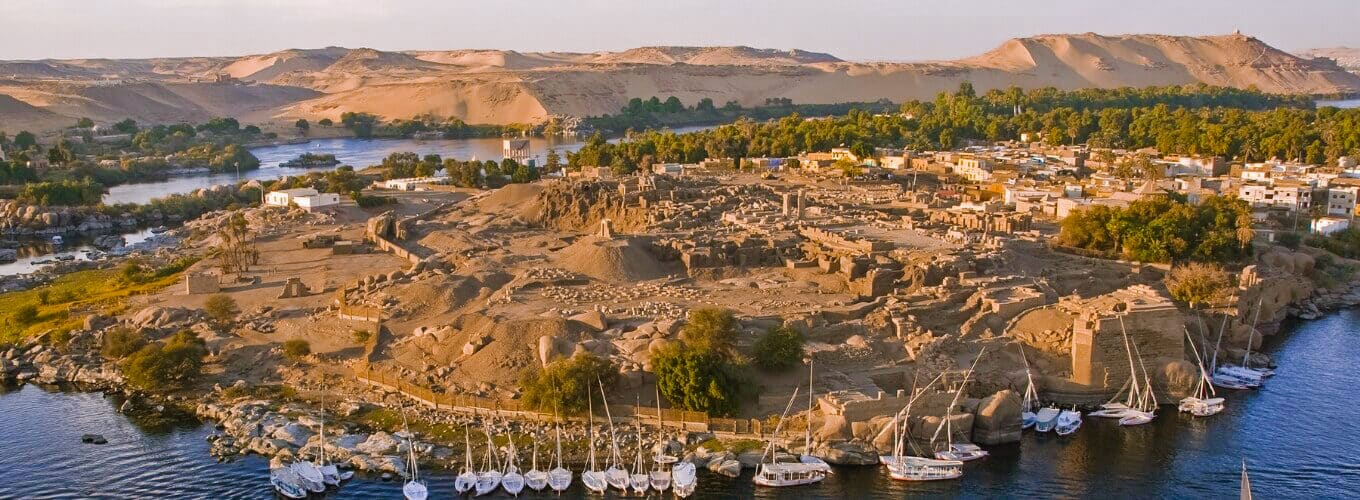
One of the essential things to see in Aswan that floats on the Nile is the Island of Elephantine. The island is in the middle of the Nile and is 12,000 meters long. It was crucial to Ancient Egypt’s strategy to protect the southern borders. Ancient Egyptian kings built a fortress on the island during the 6th Dynasty, which was more than 3000 B.C. It was also where people worshipped the god Khnum and where his temple was.
The island is full of archaeological sites and ruins of old buildings just waiting to be found. During some excavations, the German team from the archaeological institutes discovered more about some of the old buildings that still stood. The Granite gateway to a temple built by Alexander the Great was found in good shape, but figuring out the rest of the ruins was hard. Also, two columns that Ramses II made were found.
Enjoy a serene day on Elephantine Island with our top tips for a tranquil experience:
- Take a ferry from Aswan.
- Visit the Elephantine Museum.
- Explore the ruins of the ancient city.
- See the Nilometer.
- Visit the Elephantine Botanical Garden.
- See the sunset from the island.
- Enjoy the peace of the island.
- Be respectful of the island’s cultural and natural heritage.
Additional info.
Opening Times: Elephantine Island is accessible year-round, and you can explore it during daylight hours. However, it’s important to note that some of the archaeological sites or museums on the island may have specific opening times.
How to Get There: To reach Elephantine Island, you can take a boat or felucca from Aswan’s Corniche.
Travel Tips: Visit the Aswan Museum on the island to learn more about its history and archaeological discoveries. Explore the Nubian villages on the island to experience local culture and traditions.
Ticket Prices: Access to Elephantine Island itself is usually free. However, some museums or archaeological sites on the island may charge an entrance fee. Prices vary but are generally affordable, ranging from 10 to 50 Egyptian pounds (EGP). Be prepared to pay more for guided tours or access to certain areas.
5- Nubian Museum

If you would like to learn more about the culture of the Nubians, a visit to the Nubian Museum is a good idea. One thousand two hundred exhibits, landscape models, and excavations tell the story of the Nubian people. From the prehistoric past to the present, everything is included.
The Nubian Museum (officially the International Museum of Nubia) is an archaeological museum located in Aswan, Egypt. It was built following the International Campaign to Save the Monuments of Nubia. The museum is dedicated to the culture and civilization of Nubia, an ancient kingdom that flourished in southern Egypt and northern Sudan. The museum houses many artifacts, including sculptures, pottery, jewelry, and household objects.
Immerse yourself in Nubian culture at the Nubian Museum using our informative advice:
- Purchase your ticket online in advance to avoid long lines.
- Wear comfortable shoes and clothing, as you will be doing a lot of walking.
- Take your time to explore the museum and learn about the rich culture and history of Nubia.
- Be sure to see the museum’s highlights, such as the colossal statue of Amenhotep III and the painted wooden coffin from the Ballana period.
- Visit the museum’s rooftop terrace for stunning views of the city and the Nile River.
Additional info.
Opening Times: Daily from 9:00 AM to 9:00 PM
How to Get There: The Nubian Museum is located in New Kalabsha, which is about 15 kilometers south of Aswan. You can reach it by taxi, tuk-tuk, or as part of a guided tour.
Travel Tips: Try to visit during the late afternoon to avoid crowds. The museum offers a fascinating glimpse into Nubian history, so take your time exploring the exhibits.
Ticket Prices: As of my last update, the admission fee for adults is 100 EGP, and for students, it’s 50 EGP.
6- Botanical Garden

Aswan Botanical Gardens, also known as Kitchener’s Island, is a beautiful botanical garden located on an island in the Nile River in Aswan, Egypt. The island was given to Lord Horatio Kitchener, a British general, in the 1890s as a gift for his military campaigns in Sudan. Then, turn the island into a stunning garden.
Aswan Botanical Gardens is famous for its lush greenery and diverse collection of plants worldwide. The park includes many exotic plants, including palms, trees, shrubs, and flowers. Aswan’s unique climate, characterized by high temperatures and low humidity, provides an ideal environment for growing various plant species.
Explore the vibrant flora at the Botanical Garden in Aswan for a unique experience:
- If you’re visiting with children, bring a stroller or wagon. The Botanical Garden is large, and it can be tiring for young children to walk the entire distance.
- Bring a picnic lunch. There are several picnic areas at the Botanical Garden, so you can pack your lunch and enjoy it in the park.
- Take advantage of the free guided tours. The Botanical Garden offers free guided tours regularly. This is a great way to learn more about the plants and the history of the garden.
- Visit during the week if possible. The Botanical Garden tends to be less crowded on weekdays than on weekends.
- Check the website for special events. The Botanical Garden hosts various special events throughout the year, such as concerts, festivals, and educational programs.
Additional info.
Opening Times: Daily from 8:00 AM to 5:00 PM
How to Get There: Kitchener’s Island, home to the Botanical Garden, is situated in the Nile River. You can access it by taking a felucca (traditional sailboat) from Aswan’s Corniche or Elephantine Island.
Travel Tips: Wear comfortable walking shoes as you explore the lush gardens. The morning hours are the best for a visit when the weather is cooler.
Ticket Prices: The entrance fee is approximately 30 EGP per person.
7- Aswan Museum
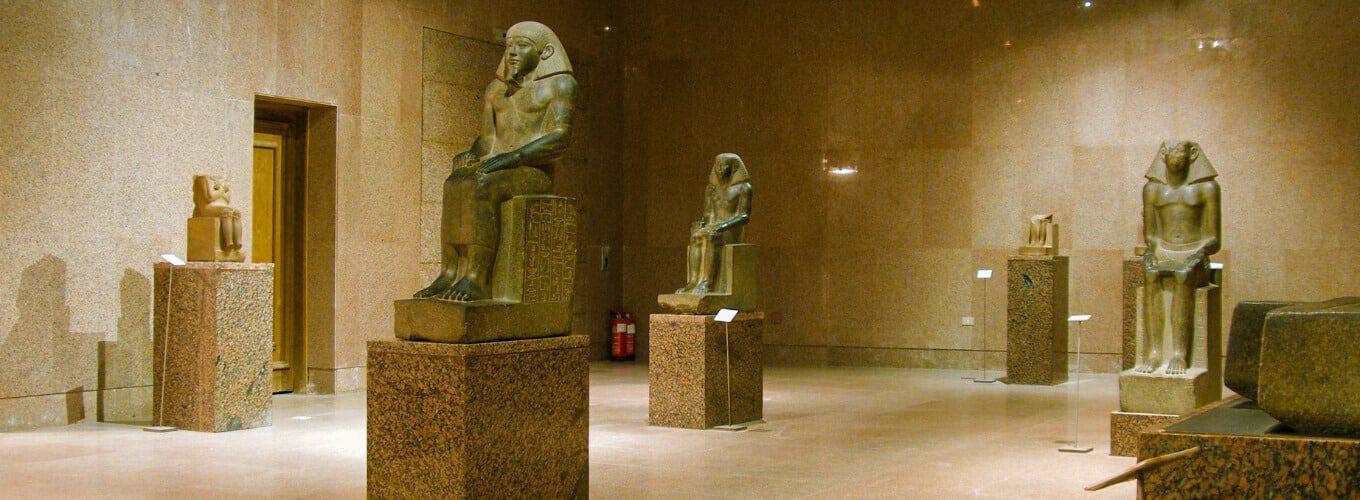
Sir William Willcocks, who built the old Aswan Dam, used to live in the Aswan Museum. It was turned into a museum to hold the artifacts on Elephantine Island and the archaeological remains found while the Dam was being built. It has things from Nubia, like statues of Amenhotep III and Ancient Egyptian gods like Khnum, who has the head of a ram, and mummies of rams, which are Khnum’s symbols.
The museum also has funerary paintings, basins made of schist from the Prehistoric period, weapons, and pottery found during excavations in Nubian areas that were in danger of being flooded by the Dam. It honors the culture and history of Nubia, which goes back to when people lived in caves. The museum was one of the 2001 Aga Khan Award for Architecture winners. It was built with local sandstone and pink granite to resemble a traditional Nubian village.
Enhance your visit to the Aswan Museum with these practical and engaging tips:
- Take advantage of the free audio guide available in multiple languages.
- Be sure to see the Nubian treasures, some of the museum’s most important artifacts.
- If possible, visit the museum on a weekday, as it is less crowded than on weekends.
- Take a break for lunch at the museum’s cafeteria, which offers a variety of Egyptian dishes.
- Don’t forget to visit the museum shop for souvenirs and books about ancient Egypt.
Additional info.
Opening Times: Daily from 9:00 AM to 5:00 PM
How to Get There: The Aswan Museum is located on Elephantine Island, and you can reach it by taking a boat from Aswan’s Corniche or by crossing the bridge connecting the island to Aswan’s mainland.
Travel Tips: Consider hiring a guide to provide insight into the museum’s artifacts and history. Visit during the morning or late afternoon to avoid the midday heat.
Ticket Prices: As of my last update, the entrance fee for adults is 40 EGP, and for students, it’s 20 EGP.
8- Nubian Village

When you go to Egypt, you must stop by a Nubian village. Out of all the things to do in Aswan, this could be the only trip that makes you feel everything. The Nubian people are so kind and welcoming; if you go to one of their family homes, you’ll be treated to great hospitality.
They have dark skin and speak Nuba or Nubian, which is the name of their language. Some people think their language is sacred and won’t teach it to anyone outside their country. Most Nubian homes are made of mud and blue or orange. Palm trees and gardens are everywhere; most farms raise chickens and goats. Some locals would sell handicrafts if they didn’t farm, and women would draw Henna on tourists to make a living—such a great trip for kids, adults, and people of all ages.
Immerse yourself in the local culture at a Nubian Village with our insightful recommendations:
- Respect the culture. Visitors should dress modestly and refrain from taking photos without permission.
- Learn a few phrases. This will show that you’re interested in the culture and make it easier to communicate with locals.
- Try the local food. Nubian cuisine is delicious and unique. Try traditional dishes like koshari, ful medames, and shawarma.
- Visit during the cooler months. The Nubian Village can be very hot in the summer, so visiting during the spring or fall is best.
Take your time. Don’t rush your visit. - Visit a Nubian home. This is a great way to learn more about Nubian life.
Additional info.
Opening Times: Visits are often arranged with local guides depending on the village.
How to Get There: Typically reached by boat from Aswan or Luxor.
Travel Tips: Engage with the local Nubian culture, enjoy traditional cuisine, and perhaps even take a Nubian cooking class.
Fun Facts: The Nubian people have a rich cultural heritage, and visiting their villages offers a unique and immersive experience.
9- Old Cataract Hotel
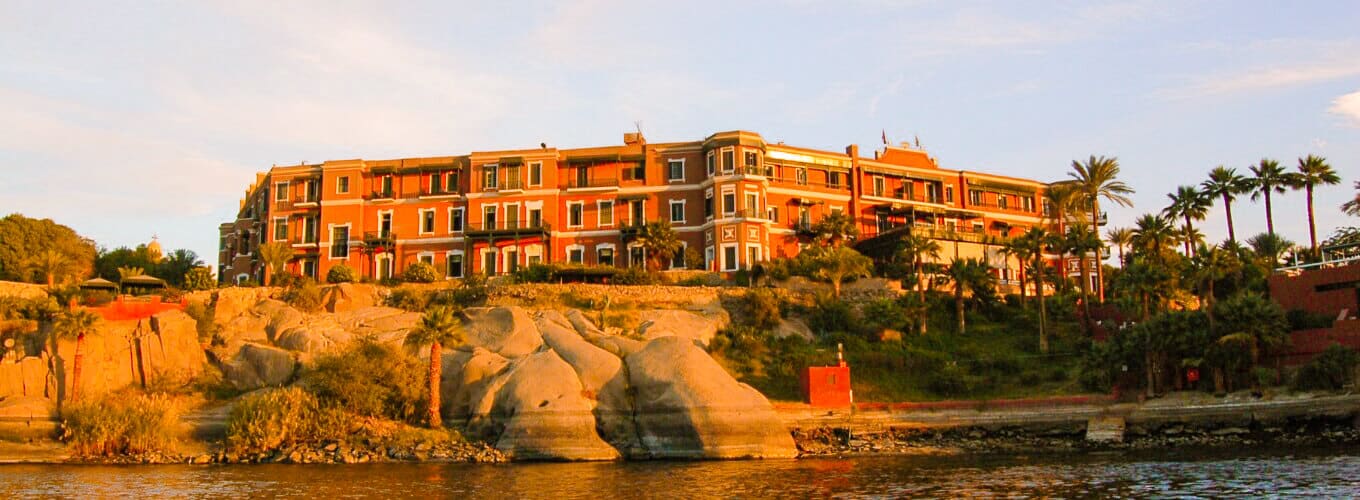
The Old Cataract Hotel is located on the east bank of the Nile and was established in 1899. Agatha Christie even wrote her world-famous crime novel “Death on the Nile” here. The luxury hotel is now a listed building and primarily attracts well-to-do guests.
Experience luxury at its finest at the Old Cataract Hotel with our helpful hints:
- Book your stay in advance, especially if traveling during peak season.
- If you’re not a guest, you can still visit the hotel and enjoy its restaurants and views.
- Walk through the hotel’s lush gardens and admire the views of the Nile River.
- Have a drink at the hotel’s famous terrace, where Agatha Christie wrote Death on the Nile.
- Book a Nile River cruise or a felucca ride from the hotel’s dock.
- Get a massage or spa treatment at the hotel’s spa.
Additional info.
Opening Times: The Old Cataract Hotel is primarily for guests staying at the hotel. However, you can dine at its restaurants, visit the terrace, or enjoy a drink with a view of the Nile. Prior reservations are recommended for dining.
How to Get There: The hotel is located near the Nile River in Aswan and is easily accessible by taxi or walking if you stay nearby.
Travel Tips: Even if you’re not staying at the hotel, visiting for a meal or a drink is a great way to experience its historic charm and enjoy stunning Nile views.
10- Aswan Dam
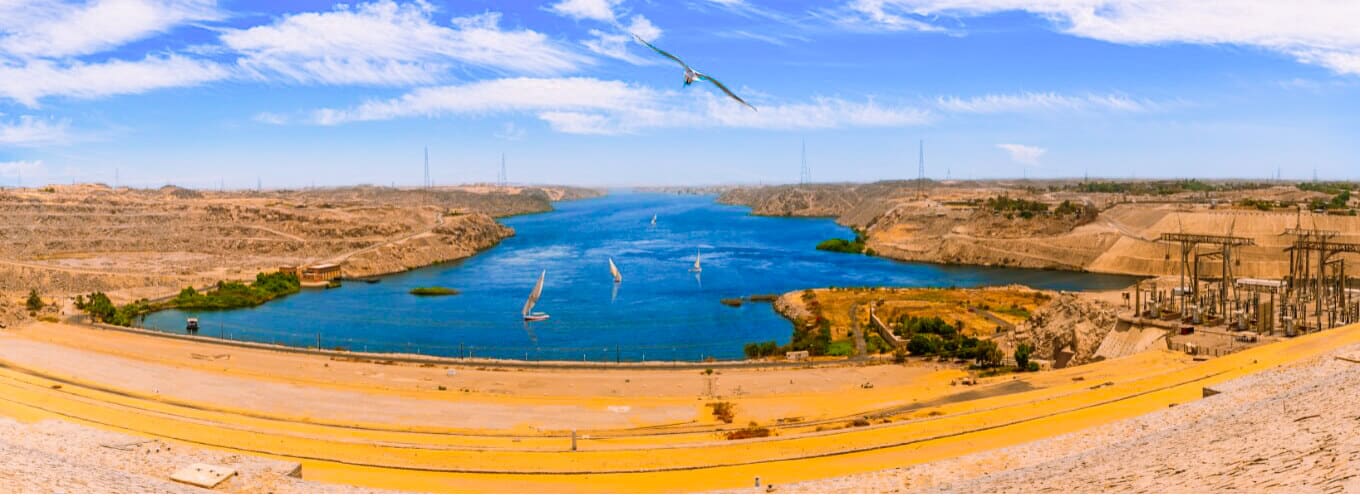
The Aswan Dam is located 20 kilometers south of the city and is one of the greatest engineering works of the 20th century. The construction of this enormous 111-meter-high Dam made it possible to control the increasingly constant flooding of the Nile and produce enough electricity for a large part of Egypt.
However, the environmental and cultural costs were also significant, moving entire towns and essential temples such as those of Philae and Abu Simbel. Once the construction was finished, it gave rise to Lake Nasser, the largest artificial lake in the world.
Learn about the engineering marvel of the Aswan Dam with our informative guide:
- Book a guided tour to learn about the dam’s history and construction.
- Wear comfortable shoes and clothing, as a lot of walking is involved.
- Bring sunscreen, sunglasses, and a hat to protect yourself from the sun.
- Drink plenty of water to stay hydrated, especially in the summer months.
- Be respectful of the dam and its surroundings.
Additional info.
Opening Times: The Aswan Dam can be seen from the outside at any time. The High Dam Visitors Center has opening hours from 9:00 AM to 5:00 PM.
How to Get There: The Aswan Dam is easily accessible by taxi or private car. To visit the High Dam Visitors Center, you can take a taxi, or it may be included in guided tours of Aswan.
Travel Tips: While you can view the dam from the outside freely, a visit to the High Dam Visitors Center offers insightful information about its construction and significance in the region’s history.
Ticket Prices: The entrance fee for the High Dam Visitors Center is typically around 40 EGP.
11- Tombs of the Nobles (Qubbet el-Hawa )
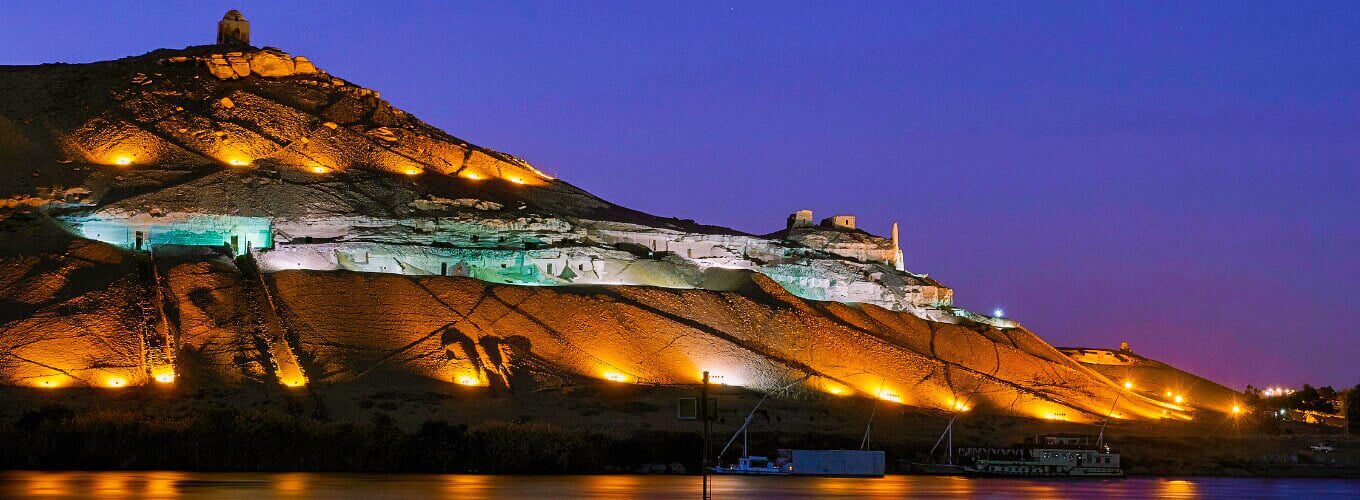
The Tombs of the Nobles, also known as the Qubbet el-Hawa necropolis, located on the other side of the Nile, in the Valley of the Princes, is another of the most exciting places to see Aswan.
In this complex carved into the rock of a hill, you can see up to 60 tombs of high officials from the late Pharaonic period (others have not yet been discovered) and mummies preserved almost intact for more than 2,500 years.
Journey into the past at the Tombs of the Nobles (Qubbet el-Hawa) with our historical insights:
- Arrive early to avoid the crowds.
- Bring a flashlight or headlamp to explore the tombs.
- Wear comfortable shoes and clothing, as a lot of walking is involved.
- Bring sunscreen, sunglasses, and a hat to protect yourself from the sun.
- Be respectful of the tombs and their contents.
Additional info.
Opening Times: Daily from 8:00 AM to 4:00 PM
How to Get There: The Tombs of the Nobles are located on the west bank of the Nile in Aswan. You can reach them by taking a short boat ride from the east bank of the Nile or by taxi.
Travel Tips: Wear comfortable shoes for walking and exploring the tombs. Hiring a local guide can enhance your understanding of the historical significance of these ancient tombs.
Ticket Prices: Admission to the Tombs of the Nobles typically costs around 40 EGP per person.
12- Monastery of Saint Simeon
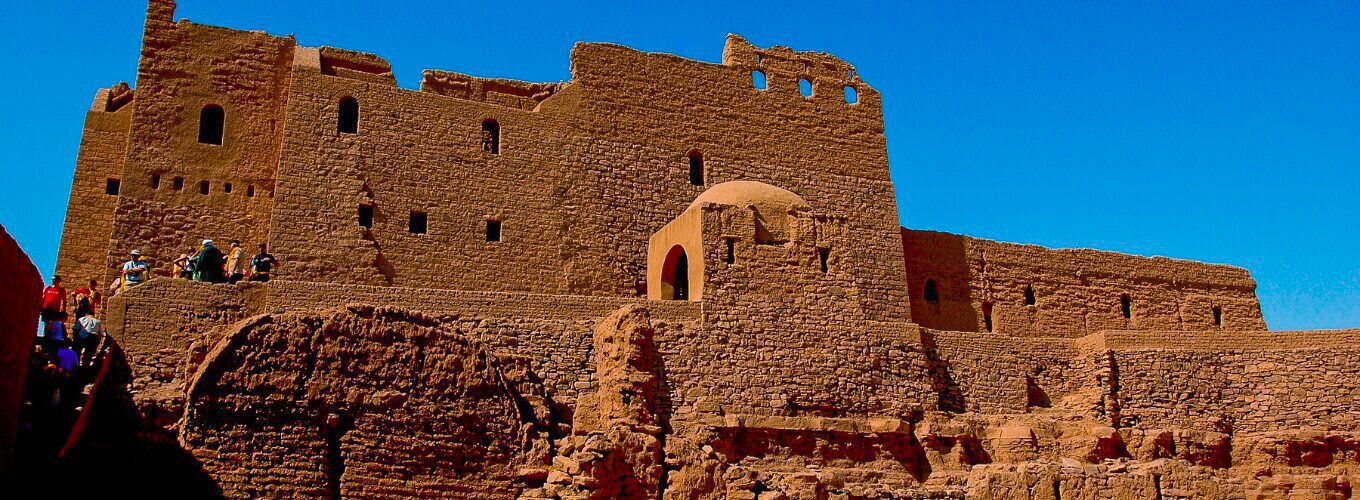
A short distance from the Tombs of the Nobles is the Monastery of Saint Simeon, built by Coptic monks in the 6th century to convert the Nubian population to Christianity and offer pilgrims rest, food, and protection.
Made of brick and stone and abandoned since the 13th century, this enormous Monastery comprises a lower terrace where the basilica remains are found. The frescoes on several walls stand out, and an upper deck where the monks’ rooms are located with their respective stone beds.
Discover the spiritual significance of the Monastery of Saint Simeon with our in-depth information:
- Bring water and sunscreen. The monastery is located in the desert, so it can be hot and dry.
- Wear comfortable shoes. You’ll be doing a lot of walking, including up and down some steep steps.
- Dress modestly. The monastery is a religious site, so it’s important to dress respectfully.
- Be respectful of the monks and other visitors. The monastery is a quiet place, so please keep your voice down and be mindful of your surroundings.
- Hire a camel ride. It’s a fun and unique way to get to the monastery, and it will save you some energy for the walk back.
Additional info.
Opening Times: Daily from 9:00 AM to 5:00 PM
How to Get There: The Monastery of Saint Simeon is located on the west bank of the Nile in Aswan. You can reach it by taxi, horse-drawn carriage, or scenic boat ride.
Travel Tips: Wear modest clothing as a sign of respect when visiting religious sites. The monastery offers a peaceful and historical atmosphere with stunning views of the Nile.
Ticket Prices: As of my last update, the entrance fee is approximately 30 EGP.
13- Mausoleum of Aga Khan
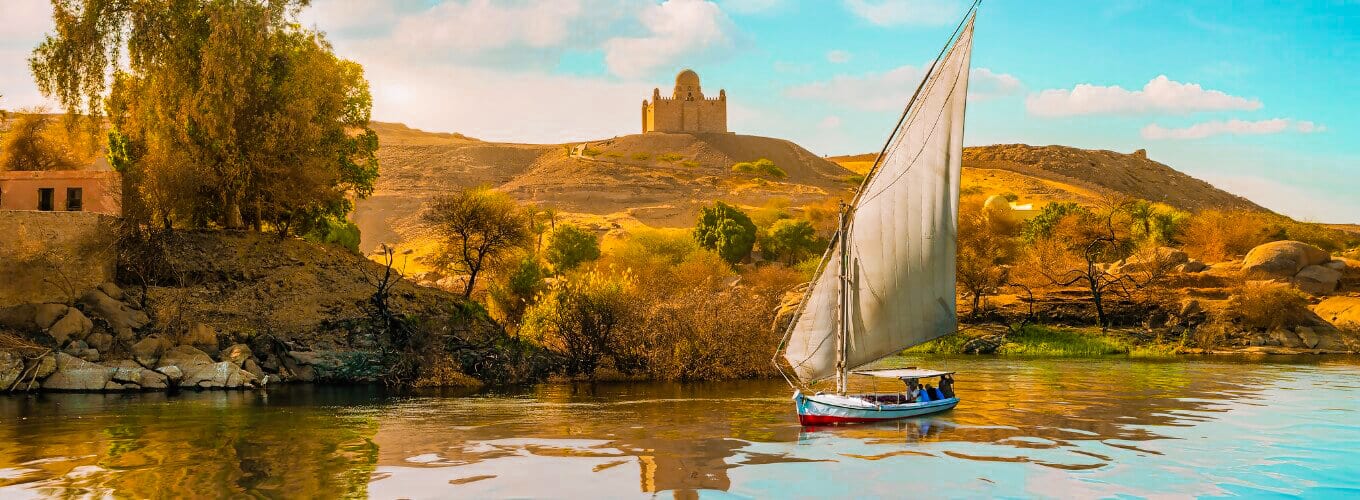
After visiting the Monastery, you can see the Aga Khan Mausoleum in a few minutes, which houses the tomb of Sultan Mahommed Shah the Aga Khan III, Imam of the Shiite Ismaili Muslims, which is also another of the places to see in Aswan.
Built with pink limestone, it is one of the most imposing buildings on the west bank of the Nile, with a solid style for the Fatimid tombs of the time. After his death, his wife supervised the construction of the enclosure and buried him two years later in it.
Pay your respects at the Mausoleum of Aga Khan with our tips for a meaningful visit:
- Visit early in the morning or late in the afternoon to avoid the crowds and heat.
- Bring sunscreen and a hat, as the mausoleum has little shade.
- Wear comfortable shoes, as you will be doing some walking.
- Be respectful of the mausoleum and its surroundings.
- Take your time and enjoy the views of the Nile River and Elephantine Island.
Additional info.
Opening Times: The mausoleum is not typically open to the public, but it can be admired from the outside.
How to Get There: The Mausoleum of Aga Khan is located on the west bank of the Nile in Aswan. You can view it from the nearby gardens or while taking a boat ride on the Nile.
Travel Tips: While you may not be able to enter the mausoleum, the serene setting and its architectural beauty make it a worthwhile stop for a photo opportunity.
14- The Famine Stela
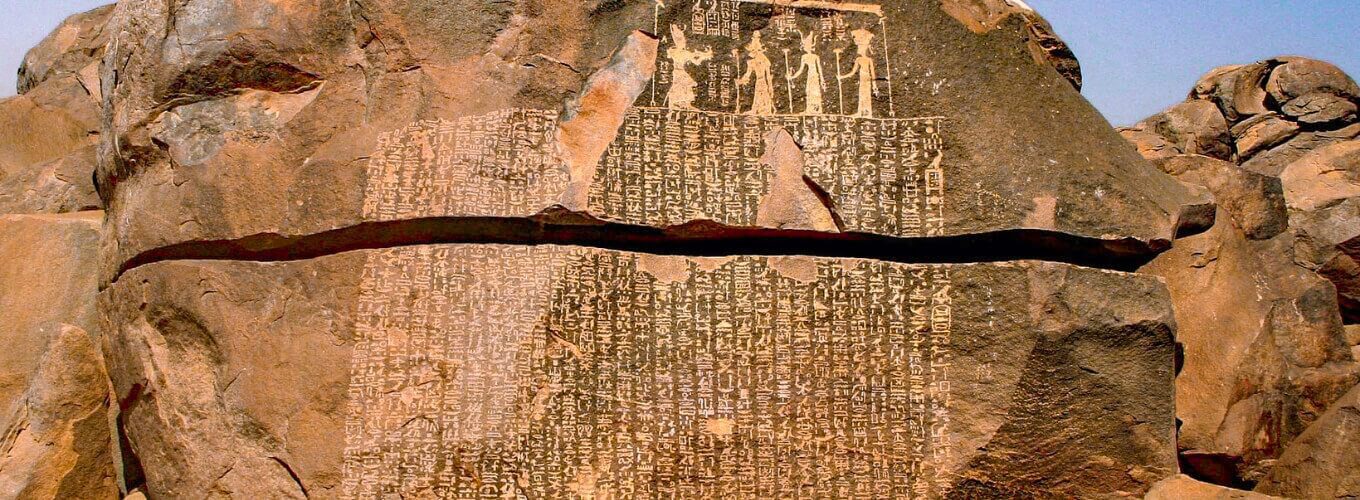
The Famine Stela is a unique Egyptian relief in Aswan that tells about the famines that occurred during the Egyptian empire. The Stele of Hunger is located on Sehel Island, where you can also see other curiosities in Aswan, such as the views of the temples from the Nile River.
Decode the ancient history of the Famine Stela with our guide to its significance:
- Take a boat trip to Sehel Island, where the stela is located.
- Wear comfortable shoes, as you will be doing some walking on uneven terrain.
- Bring water and sunscreen, as there is little shade on the island.
- Be respectful of the stela and its surroundings.
- Take your time to read the inscription on the stela and learn about its history.
- Hire a guide to explain the significance of the stela and answer any questions you may have.
- Take photos of the stela and the beautiful views of the Nile River and Elephantine Island from Sehel Island.
Additional info.
Opening Times: Open-air site, accessible year-round.
How to Get There: The Famine Stela is located on Sehel Island in the Nile River. You can arrange boat trips or felucca rides to visit the island and view the stela.
Travel Tips: Take precautions against the sun, as there may not be much shade on the island. The Famine Stela is a historical inscription worth exploring for its significance in the region’s history.
Ticket Prices: Access to view the Famine Stela is usually included as part of a boat tour package. Tour prices may vary, so check with operators for the current rates.

Other places to visit behind Lake Nasser in Aswan
15- Lake Nasser
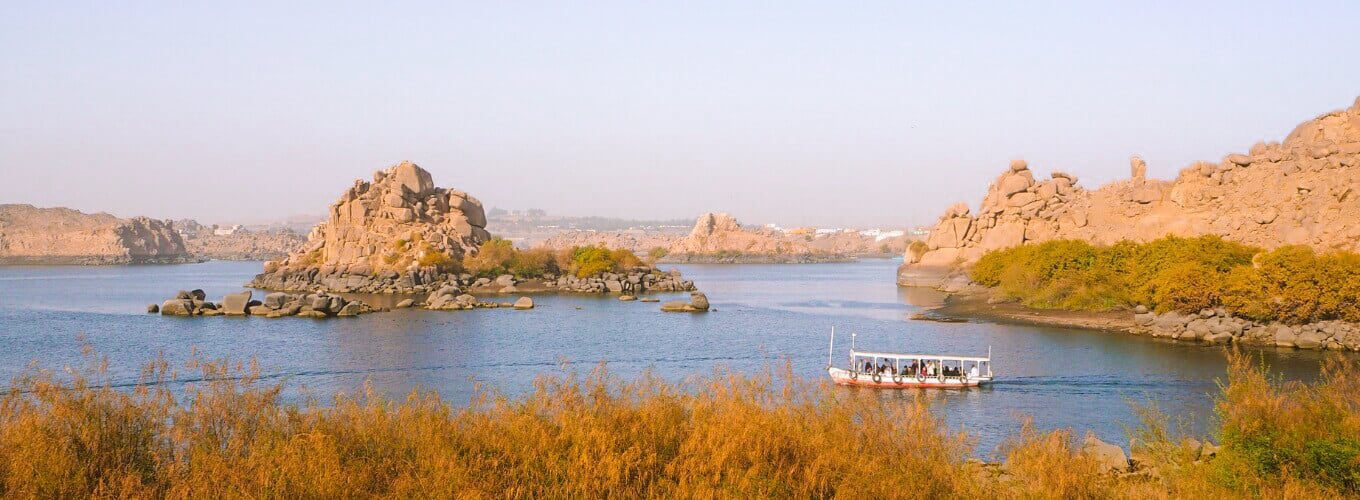
Lake Nasser is a lake made by people in one of the Nile River’s basins. It is in the southern part of the country and goes beyond Sudan’s borders. Only the amount of Lake Nasser in Egypt, about 85% of the whole lake, is called Lake Nasser. The part of the lake that is in Sudan is called Lake Nubia.
It was made after the Aswan Dam was built, which took place between 1958 and 1970. The most critical area, near the Tropic of Cancer, is about 550 kilometers long and 35 kilometers wide. It covers a total area of about 5,250 square kilometers and has a water capacity of 157 square kilometers.
Cruise the serene waters of Lake Nasser with our tips for a relaxing journey.
- Book a cruise on a reputable Nile cruise ship.
- Bring a camera to capture the stunning scenery, including the lake, surrounding desert mountains, and ancient temples and ruins.
- Lake Nasser is a great place to do it if you’re interested in fishing. The lake has many different fish species, including Nile perch, catfish, and tigerfish.
- If you’re visiting during the winter, pack a warm jacket, as the nights can be quite cold.
Additional info.
Opening Times: As it’s a natural reservoir, Lake Nasser is accessible year-round. However, access to certain areas may depend on guided tours and cruises.
How to Get There: Lake Nasser can be explored through guided tours and cruises departing from Aswan. You can reach Aswan by air, train, or bus from major Egyptian cities.
Travel Tips: Ensure you have proper sun protection and carry essentials as you explore the lake’s surrounding temples and monuments. Joining a guided tour or cruise is the best way to see the area’s attractions.
Ticket Prices: Tour and cruise prices vary depending on the duration and itinerary. It’s best to check with tour operators for current rates.
16- Temple of Dakka

El Dekka was known to the ancient Egyptians as Pselqet and the ancient Greeks as Pselchis. Today, the Temple of Dakka is on a small cliff, the only Nubian temple with a north-facing facade and a north-south orientation that runs parallel to the Nile.
It is 50 km north of where it is now. It is dedicated to Thot, the god of wisdom, and is known for its 12m high tower, which you can climb to see Lake Nasser and other temples. It is one of the temples in Egypt that people know the most about.
Step back in time at the Temple of Dakka with our recommendations for a memorable visit:
- Book a tour or hire a private driver to take you to the temple.
- Bring water, sunscreen, and a hat, as the sun can be very strong at the temple.
- Wear comfortable shoes, as you will be doing some walking on uneven terrain.
- Climb to the top of the pylon for stunning views of the surrounding desert and Lake Nasser.
- Visit the temple early in the morning or late in the afternoon to avoid the crowds and heat.
- Hire a guide to explain the significance of the temple and answer any questions you may have.
- Take photos of the temple and the beautiful desert landscape around it.
Additional info.
Opening Times: Daily from 8:00 AM to 5:00 PM
How to Get There: The Temple of Dakka is located near Lake Nasser. It’s accessible via guided tours and cruises departing from Aswan or Abu Simbel.
Travel Tips: Dress modestly and wear comfortable walking shoes. A guided tour can provide historical context and enhance your visit.
Ticket Prices: The entrance fee for the Temple of Dakka is approximately 40 EGP.
17- Beit el-Wali

Beit el-Wali was saved from Lake Nasser by a Polish archaeological team, paid for by a joint project between the Oriental Institute of Chicago and the Swiss Institute of Cairo.
The temple was built in the shape of a cross, which was symmetrical. It has a deep hall, a long room with two columns in the middle, and a sanctuary. The temple called a speos, was mainly cut out of the rock around it, except for the front wall of the deep hall, which had a door in the middle.
The reliefs on the deep hall are crucial to history because they show how the Syrians, Libyans, and Ramesses II won against the Nubians. In the scenes of the Nubian campaigns, several of Ramesses II’s sons are seen fighting in the war.
Explore the archaeological wonders of Beit el-Wali with our insightful advice:
- Visit early in the morning or late in the afternoon to avoid the crowds and heat.
- Bring water and sunscreen, as there is little shade around the temple.
- Wear comfortable shoes as you walk up and down some steep steps.
- If you’re interested in architecture, be sure to check out the unique design of the temple. It’s carved into the rock face and has two proto-Doric columns in the front hall.
- If you’re visiting with children, supervise them closely, as there are some steep steps and cliffs around the temple.
Additional info.
Opening Times: Daily from 8:00 AM to 5:00 PM
How to Get There: Beit el-Wali is situated near Lake Nasser and is accessible through guided tours and cruises departing from Aswan or Abu Simbel.
Travel Tips: Wear comfortable clothing suitable for the desert environment. Guided tours are recommended for a better understanding of the site’s history.
Ticket Prices: The entrance fee for Beit el-Wali is approximately 40 EGP.
18- Temple of Wadi es-Sebua
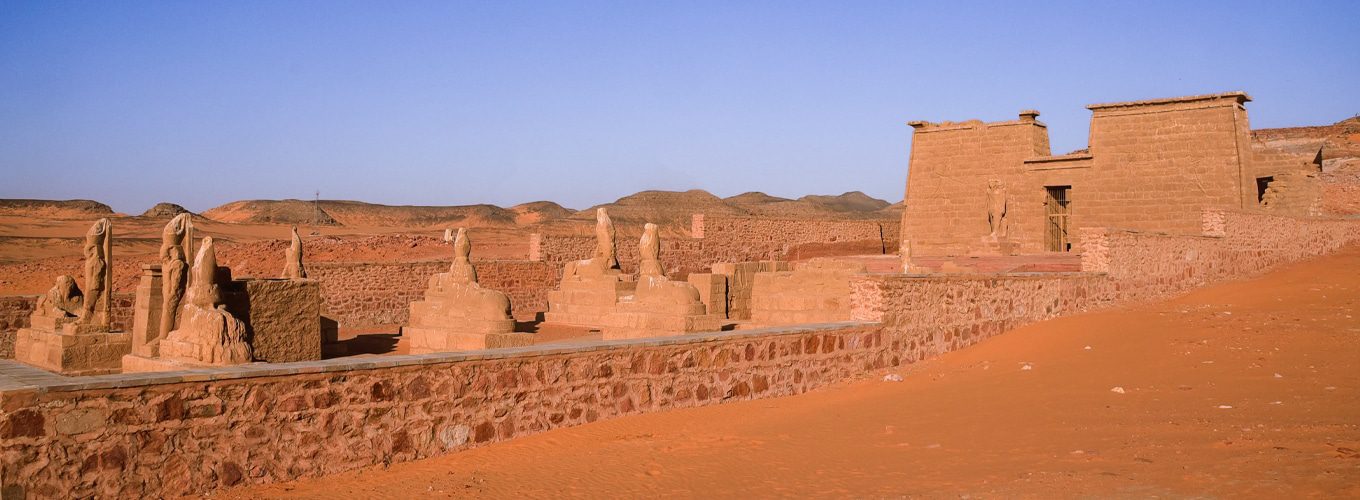
220 km south of Aswan is the Temple of Wadi es-Sebua. Prince Setaw, who was the ruler of Nubia, built it. It shows that Egypt, the state in the south, is getting stronger and that its enemies are dying. After Abu Simbel, the Temple of Wadi es-Sebua is the second-largest Nuba temple.
Abu Simbel is on the World Heritage List, a list of scientific and cultural sites kept by the United Nations. On Lake Nasser, he is known by his ancient pharaonic name, “Ramses Beloved Amun in the town of Amun.” Seto gave him to King Ramses II, Amon-Ra, Ra-Hor, and Ptah. He has his old name from when he was a pharaoh on Lake Nasser.
Journey to the past at the Temple of Wadi es-Sebua with our historical insights:
- Bring plenty of water and sunscreen.
- Wear comfortable shoes.
- Visit early in the morning or late in the afternoon to avoid the heat.
- Hire a guide to learn more about the temple’s history and significance.
- Be respectful of the site and its religious significance.
- Take your time and enjoy the amazing architecture and reliefs.
Additional info.
Opening Times: Daily from 8:00 AM to 5:00 PM
How to Get There: The Temple of Wadi es-Sebua is located near Lake Nasser and is accessible through guided tours and cruises from Aswan or Abu Simbel.
Travel Tips: Bring plenty of water and sun protection. Guided tours can enhance your understanding of the temple’s history.
Ticket Prices: The Temple of Wadi es-Sebua entrance fee is approximately 40 EGP.
19- Qasr Ibrim
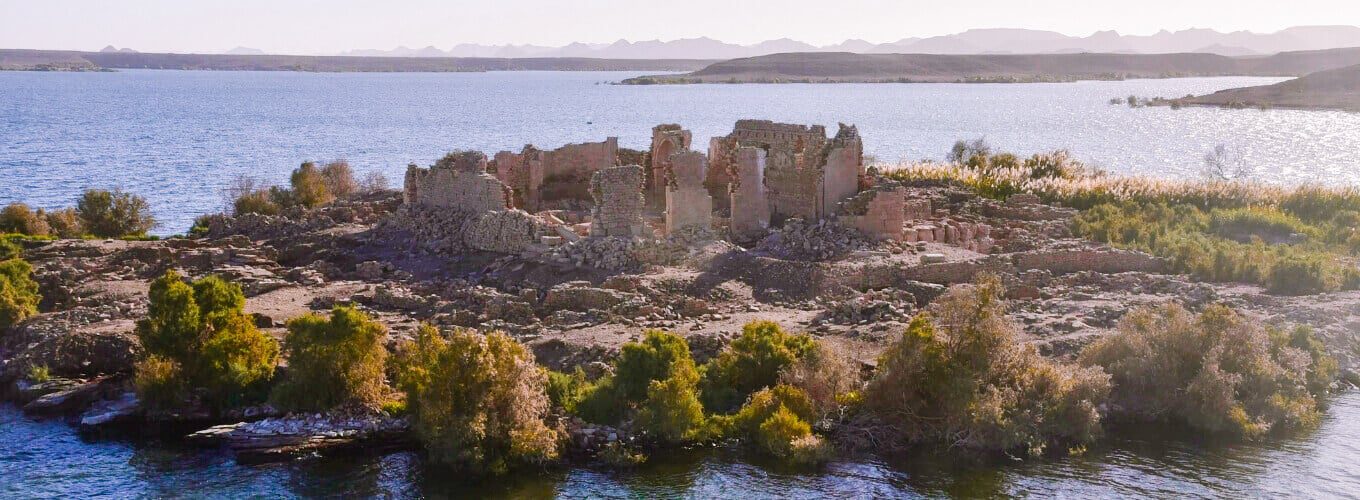
Qasr Ibrim is 235 km south of Aswan and 60 km north of Abu Simbel. The most important of the three massifs south of the village of Ibrim is the one in the middle. All the reused monuments from the New Empire show that the fort or castle of Qasr Ibrim was built on pharaonic foundations. The temple building at Taharqa and the Stele of Amenhotep I are two of the oldest.
It used to be a city on the Nile, but the Aswan Dam turned it into an island. Now, the tallest part of the temple is the only thing that can be saved. Qasr Ibrim is the only archaeological site in Lower Nubia that has survived the floods of the Nile, and it is an important site for archaeological research.
Discover the history of Qasr Ibrim with our informative guide to this ancient site:
- Visit Qasr Ibrim in the cooler months, from November to February.
- Respect local customs and dress modestly when exploring the site.
- Bring sunscreen and a hat to protect yourself from the strong sun.
- Plan a boat trip to Lake Nasser to see the submerged parts of the temple.
- Hire a local guide to learn more about the history of Qasr Ibrim.
- Explore nearby archaeological sites like Abu Simbel and Philae Temple.
Additional info.
Opening Times: Access to the island is typically arranged as part of guided tours.
How to Get There: You can visit Qasr Ibrim as part of guided tours and cruises that include stops at various sites around Lake Nasser.
Travel Tips: Be prepared for a boat ride, and ensure you follow the rules and guidelines set by the tour operators for visiting this island site.
Ticket Prices: The cost for guided tours that include Qasr Ibrim varies depending on the tour package. It’s best to check with tour operators for current rates.
20- Temple of Kalabsha
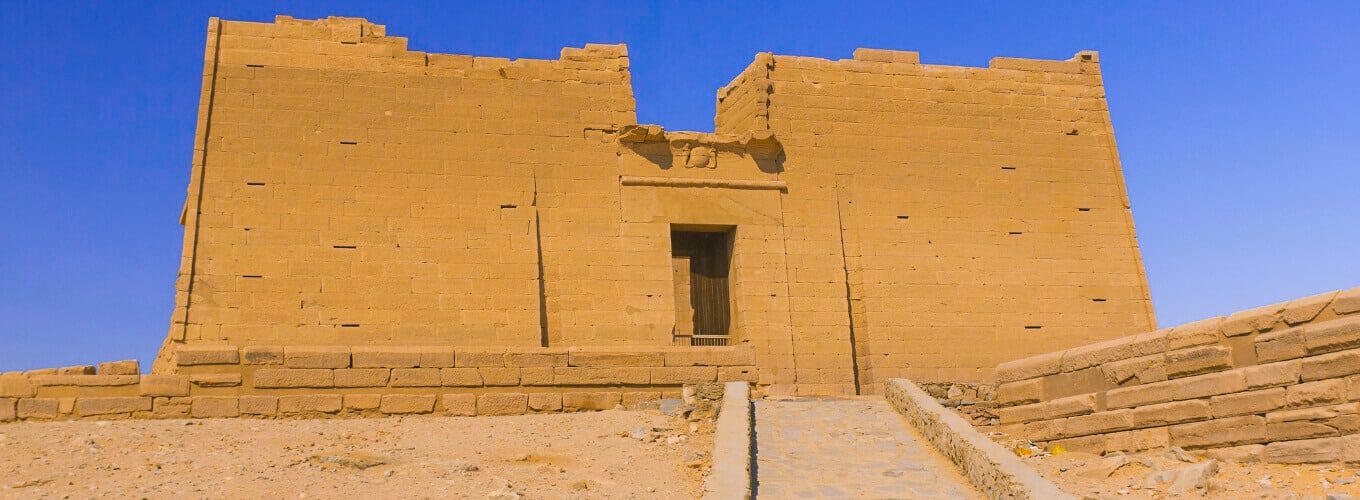
The Temple of Kalabsha is the largest free-standing temple in Lower Nubia and the most beautiful and well-kept one. It was built during the time of Augustus, the first Roman emperor, who ruled from 30 BC to 14 A.D. This Place of worship was mainly for the Nubian god Mandulis but also for the gods Isis and Osiris, who were Isis’s husbands.
The plan for the temple is regular. A large entrance called a “pylon” leads to an open-air “forecourt” and then to a “hypostyle hall,” which is a room with columns. Beyond that are two cross-shaped chambers used as places to make offerings. The temple of Kalabsha has marks from many different cultures, like the fact that it is dedicated to a god from Nubia and has been written in Meroitic and Greek. The thin columns and wide spaces between them are signs of Greek and Roman influence. Several crosses carved into its walls show that the sanctuary was used as a church when Christianity first came to the area.
Immerse yourself in the grandeur of the Temple of Kalabsha with our expert tips:
- Dress appropriately for the heat and sun.
- Bring sunscreen, a hat, and sunglasses.
- Drink plenty of water throughout the day.
- Wear comfortable shoes, as you will be doing a lot of walking.
- Visit early in the morning or late in the afternoon to avoid the crowds.
- Be aware that there are no shops or restaurants at the temple site, so bring your own food and drinks.
Additional info.
Opening Times: Daily from 8:00 AM to 5:00 PM
How to Get There: The Temple of Kalabsha is accessible through guided tours and cruises departing from Aswan or Abu Simbel.
Travel Tips: Wear comfortable clothing and shoes suitable for walking. Guided tours can provide historical context and make your visit more informative.
Ticket Prices: The entrance fee for the Temple of Kalabsha is approximately 40 EGP.
21- Amada Temple
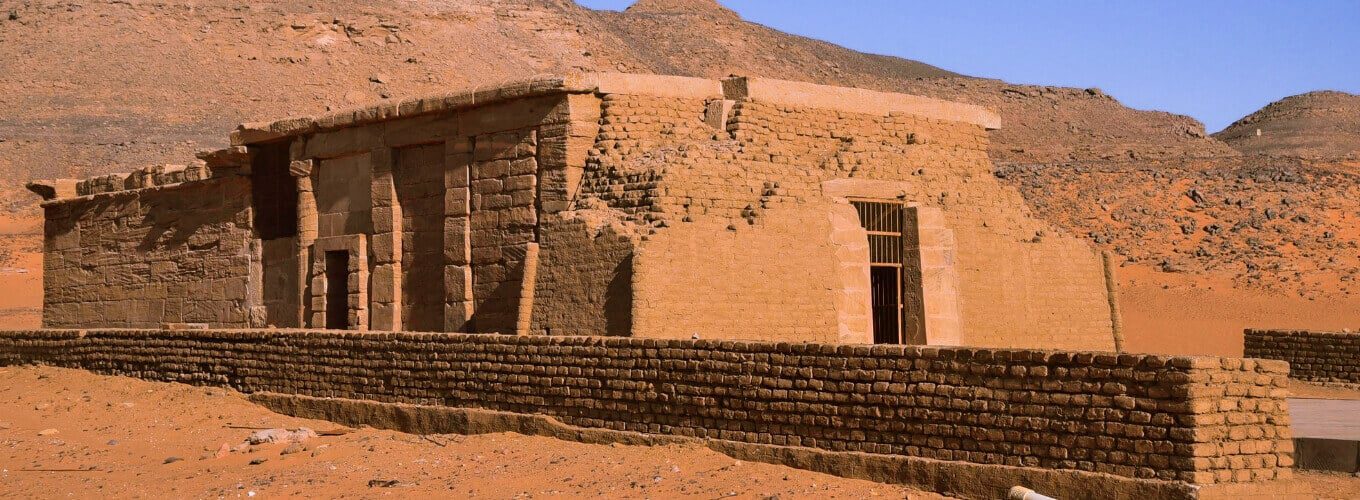
The temple of Amada is one of the oldest ancient Egyptian buildings. It was built during the 18th Dynasty (around 1550–1295 BC) of the New Kingdom, and it stands on the shores of Lake Nasser. When the temple was turned into a church, a layer of plaster was put on top of the reliefs and inscriptions to keep them from getting damaged.
Kings from three different eras built this beautiful temple. Thutmose III (around 1479–1425 BC) and his son Amenhotep II (around 1427–1400 BC) made the central part of the temple. Thutmose IV (about 1400–1390 BC) added the beautiful hypostyle hall in front. During the 19th Dynasty, minor changes and additions were made (1295–1186 BC).
Experience the cultural richness of the Amada Temple with our recommendations for a meaningful visit:
- Visit Amada Temple early in the morning to beat the crowds.
- Respect the dress code – wear modest clothing.
- Bring a hat and sunscreen, as it can get hot.
- Stay hydrated – bring water with you.
- Don’t forget your ticket or pass for entry.
- Learn about the temple’s history before your visit.
Additional info.
Opening Times: Daily from 8:00 AM to 5:00 PM
How to Get There: The Amada Temple is accessible through guided tours and cruises departing from Aswan or Abu Simbel.
Travel Tips: Bring essentials like water and sun protection. Guided tours can enhance your understanding of the temple’s history.
Ticket Prices: The entrance fee for the Amada Temple is approximately 40 EGP.
